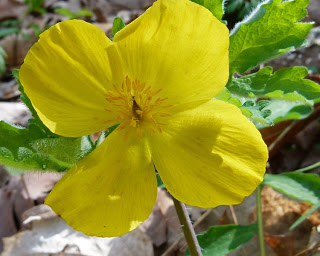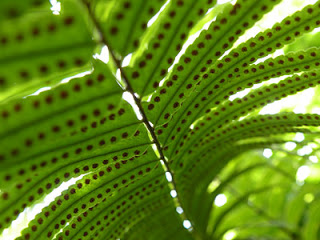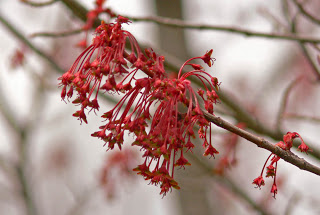 |
| Wood Poppy |
We tend to take flowers for granted. They are pretty and smell nice in the spring. We like to have them in our gardens.We know that flowers must bloom before the fruits can develop, but most people don’t consider the miracle of flowers.
 |
| Corn Blossom |
In fact, flowering plants are by far the largest group of plants and the most important from an ecological standpoint. They inhabit all sorts of environments. They make up the majority of a lot of different habitats, such as grasslands (all the grasses are flowering plants), most forests (except for the boreal forests), and most terrestrial habitats on the face of the planet. They provide food sources and shelters for the organisms that live in these habitats. On a more personal note to humans, they provide us with most of our food and a lot of our shelter materials, such as wood. Different species of insects and mammals may rely on only one flowering plant for food, and that plant relies on the insect/mammal to reproduce. In fact, there would be no people without flowering plants. NOVA has a wonderful discussion of plant development at ttp://www.pbs.org/wgbh/nova/transcripts/3405_flower.html.
 |
| Fern Frond with Spores |
Before flowers, the Earth was covered with green plants like ferns, pines, and the now-extinct seed ferns. Their reproduction was relatively slow and inefficient. Pollination was mostly carried out by the wind. The small brown spots we see on the bottom of a fern frond, for example, are actually the spores waiting to be spread by the wind. They carry nothing to promote successful growth in a new location.
 |
| Cream Violet |
Flowering plants were the first advertisers in the world. They put out beautiful petals and colorful patterns; they put out fragrances, and they gave a reward, such as nectar or pollen, for any insect that would come and visit them. Sometimes they display stripes and special colors directing the pollinators to the sweet spot! And what were they advertising? They were advertising the sexual organs, the female parts and the male parts that were hidden or positioned within the center of this flower. So if they could attract these mobile pollinators to come and mess around, crawl around, feed in this flower, pick up pollen on the legs, pick up pollen on the body, and then fly to another flower some distance away and repeat this process, they could effectively carry their male genetic material in the pollen grain to another flower. The very earliest flowering plant pollen shows up in rocks, which are of cretaceous age, which is about 134 million years ago.
 |
| Red Maple Blossom |
The variety of flower appearance and structure is absolutely mind boggling! Compare the spring wildflowers we have been looking at lately with these tree blossoms. We think of apple and other fruit trees as “flowering”, but oaks, cottonwoods and all other trees do too. We simply don’t recognize their flowers for the most part. Grains such as corn, wheat, oats and rice are all flowering plants too, and we rely on the seeds produced by those inconspicuous flowers for our own food. But the important thing is the way these plants make seeds. A protective covering is created around the part that will grow into a plant, and provided with nourishment to assist that growth, such as the pulp of the apple around apple seeds. This method of reproduction takes a lot of energy on the part of the plant, so it’s amazing that plants still make as many seeds as they do. For example, just consider the maple seeds that will soon cover our yards and driveways! Ah, the things Mother Nature will do to make sure her children survive!
